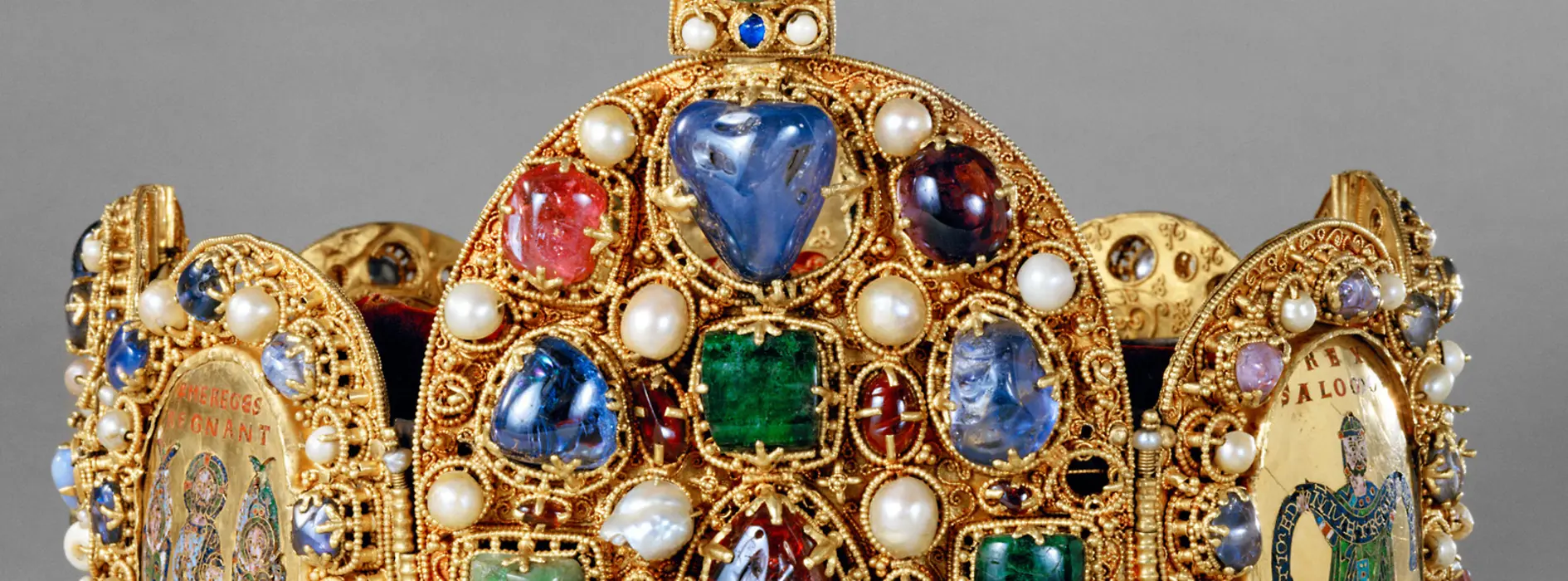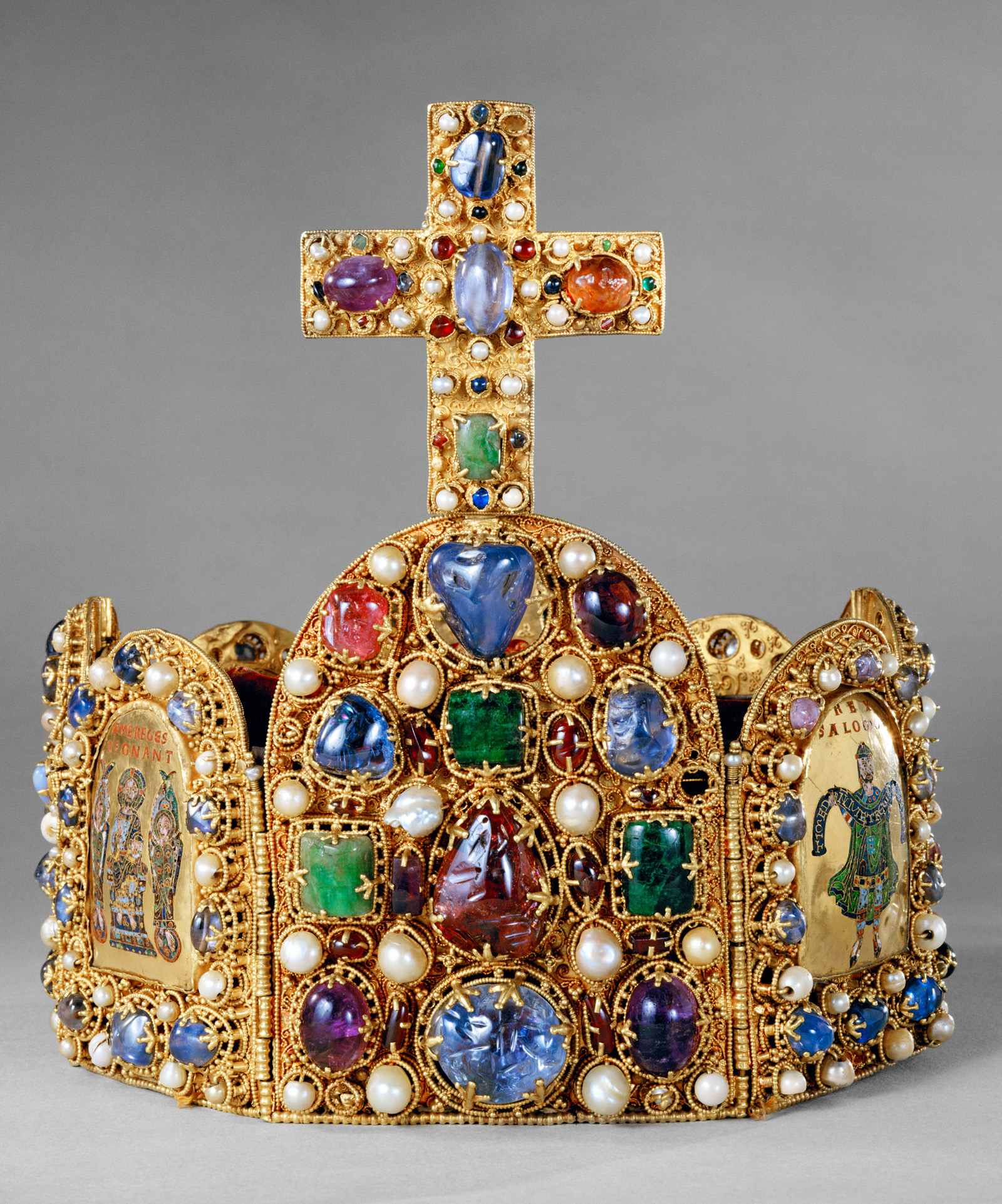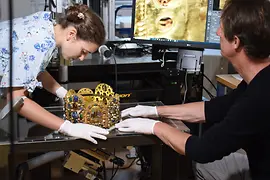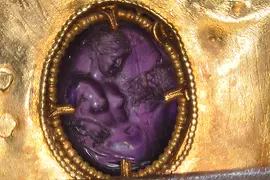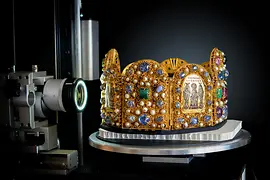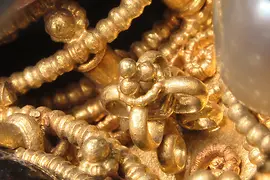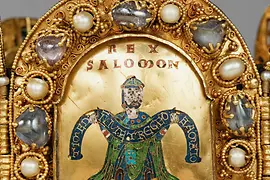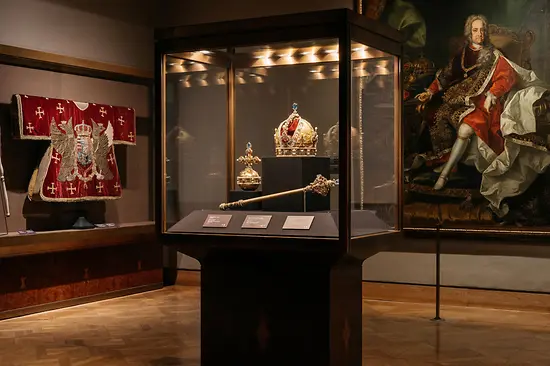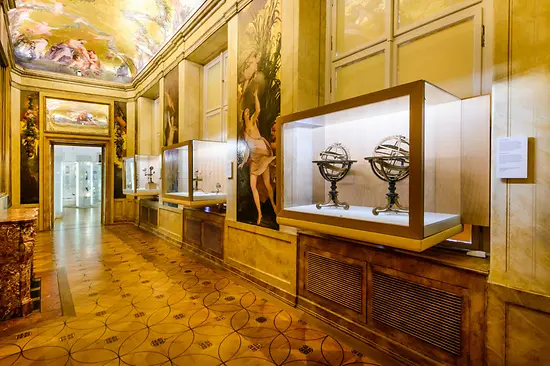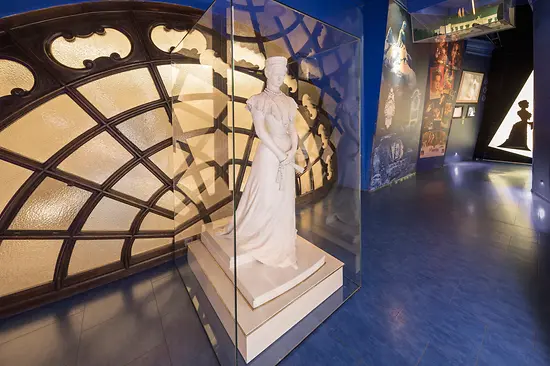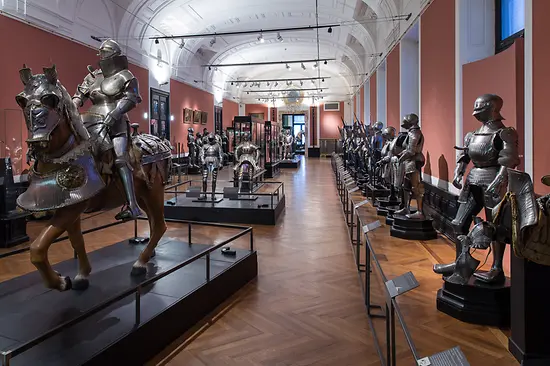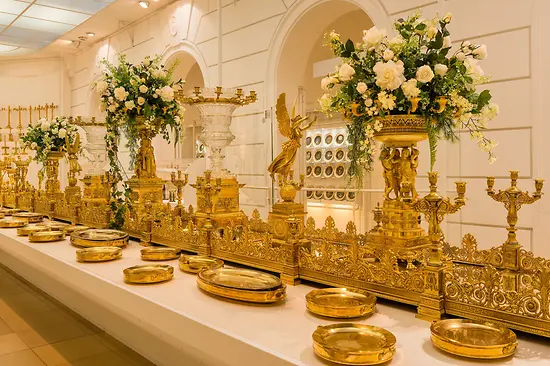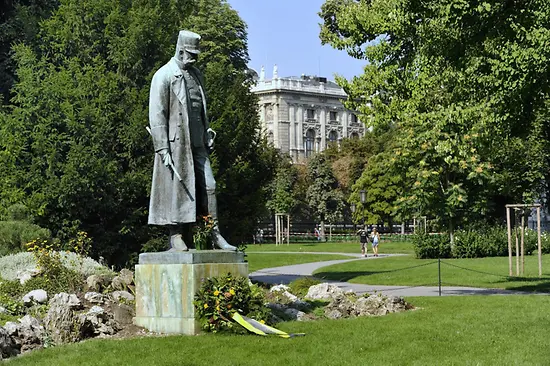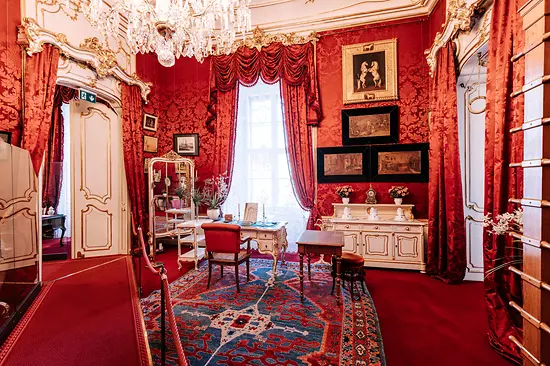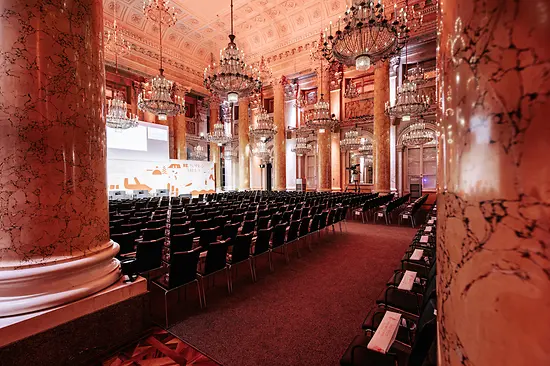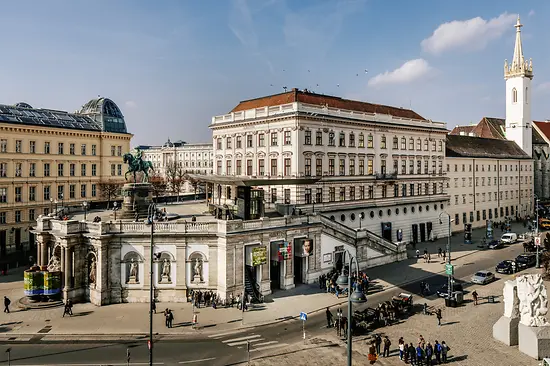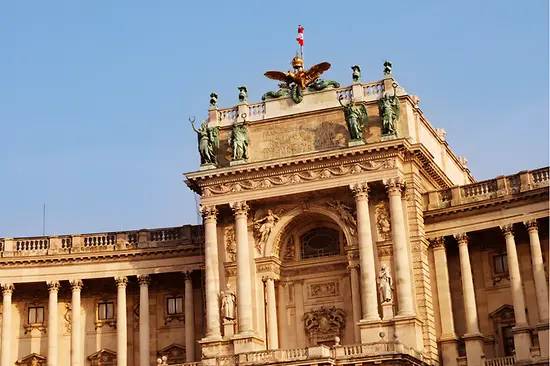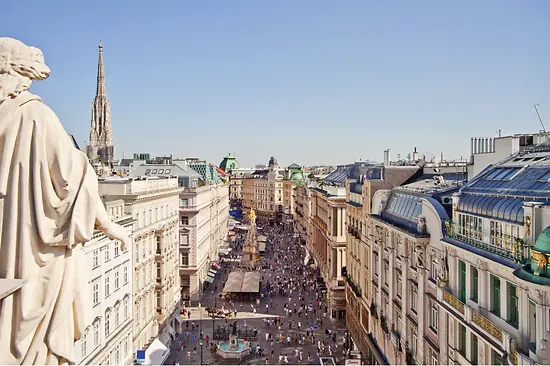Crown Witness
It is the highlight of the Imperial Treasury in Vienna, and part of the oldest, most comprehensive collection of medieval regalia: the Imperial Crown, which was used for the coronations of the kings and emperors of the Holy Roman Empire from the Middle Ages all the way through to 1792. But now, the octagonal crown was being examined in minute detail for the first time.
Numerous myths surround this extraordinary example of the goldsmith’s art. No one knows when – or where – it was actually made. For a long time it was thought that the crown was created for Emperor Charlemagne and his coronation in the year 800 AD. “But this myth was debunked a long time ago,” explains art historian Franz Kirchweger, who is leading the project for the Kunsthistorisches Museum Vienna (which the Imperial Treasury belongs to): “That said, contentious ideas continue to surface when it comes to dating the piece: they range from the time of Emperor Otto the Great, who was crowned in 962, to the reign of King Conrad III from 1138 to 1152.” And now an attempt was being made to use cutting-edge technology to crack this historical conundrum once and for all.
State-of-the-Art Research Tools
X-ray fluorescence analysis and 3D digital microscopy were among the principal methods being deployed to come up with answers. Whatever the technique, one thing is always the same: owing to its fragility, the crown could not come to the equipment, so the equipment had to come to the crown in Vienna. X-ray fluorescence analysis can be used to determine the precise chemical composition of materials. “This delivers important information about things like enameling and metal alloys,” Kirchweger reveals.
3D digital microscopy makes it possible to grade the pearls, gemstones and decorative elements, and to determine their dimensions. At up to 2,500-times magnification. “By the end of 2022, we’d taken 60,000 images with it,” Kirchweger notes. In May 2022, all 172 stones on the crown had been identified for the first time: 71 sapphires, 50 garnets, 20 emeralds, 13 amethysts, four chalcedonies (a semi-precious gemstone), three spinels (a type of mineral) and eleven differently colored pieces of glass. The expert explained that X-ray fluorescence analysis will help uncover even more information about the origin of the stones.
Examining the crown’s inner plates without damaging them posed a particular challenge. To do so, the lens of the 3D microscope was mounted on a movable arm. And a table with an octagonal opening was constructed to allow the lens to be inserted inside the crown from beneath. The result: high-resolution scans of all of the plates that come together to form the band of the crown, the hoop, the cross, and the enamel plaques.
“Sensational!”
A spectacular discovery was made along the way: two ancient amethyst intaglios – cut gemstones with a pictorial representation – were uncovered on one of the inner plates. They show a mythical figure with a theater mask, and a harbor scene. Kirchweger: “It is truly sensational!” Particularly because the sides of the image are turned inward and not visible from the outside, as a result. “Research has been conducted on the crown for nearly 250 years. The fact that we were still able to discover something completely new really is quite extraordinary.” The use of the 3D digital microscope also had a decisive role to play here. The intaglio featuring the theater mask is the earliest and most beautiful example of its kind. It was probably created getting on for 2,100 years ago.
However, taken in isolation, the data obtained is of little use to the researchers. Kirchweger: “We need related material to help us interpret the facts and make comparisons.” To do this, eight pieces from a similar period (10th and 11th century) were selected. Among them goldsmith’s work from the Treasury at Essen Cathedral and a golden book cover that has been restored at the Louvre in Paris. “It is important to examine these precious pieces on site using the same methods and equipment,” Kirchweger explains.
Slipped from the Cushion
Historical images and texts were also being sought out and sifted through to provide additional insights. For example, to determine if and where any changes have been made over the centuries. Kirchweger: “Our colleague Evelyn Klammer combed through over 6,000 pieces of data. 600 images were added to our database as a result for closer examination.”
This also applies to damage, such as the documented loss of a gemstone at the coronation of Joseph II as Roman-German King in Frankfurt am Main in 1764. “On the way to the coronation church, the crown slipped off the cushion it was resting on. In the process, a sapphire from the back plate was lost,” Kirchweger recounts. “The stone was replaced with a hyacinth. Today, you can still see that there is a different border at this point than for the other stones.”
Display alternative text
Video: Untersuchungen zu Materialität, Technologie und Erhaltungszustand der Wiener Reichskrone
Eventful History
The crown, which weighs in at impressive 3.5 kilos, has been through a lot of adventures. Probably made in a workshop somewhere in the Lower Rhine region, it is mentioned for the first time in 1246. From 1424, this piece of imperial regalia was kept in Nuremberg. In 1792, the last coronation of a Holy Roman Emperor took place. And then Napoleon swept across Europe. To keep the precious crown out of his clutches, it was spirited to safety and ended up in Vienna. In 1827, it was put on show at the Imperial Treasury. In 1938, Hitler had it returned to Nuremberg. Kept in a beer cellar that was converted into a bunker and later walled into an alcove, the crown survived the Second World War unscathed. In 1946, it returned to Vienna for good.
The research project lasted until the end of 2024. Eight people from the fields of art history, history, restoration and natural science were hard at work unlocking its final secrets. But did they find out when the crown was made and when it was used for the first time? Kirchweger has a diplomatic answer for us: “In my estimation, we’ll have to continue to work off assumptions and informed speculation. But that doesn’t mean that we’re not already hoping we’ll be able to narrow down the time frame.” So watch this space.
Text: Robert Seydel
- Hofburg, Schweizerhof, 1010 Wien
- info@khm.at
- http://www.kaiserliche-schatzkammer.at
Vienna City Card
-1 € off the full price
Prices
- Free admission for young people under 19 years of age
Opening times
- Mo, 09:00 - 17:30
- We, 09:00 - 17:30
- Th, 09:00 - 17:30
- Fr, 09:00 - 17:30
- Sa, 09:00 - 17:30
- Su, 09:00 - 17:30
Accessibility
no steps (Double swinging doors 200 cm wide)
Parking spaces for people with disabilities
Public parking spaces for people with disabilities on Heldenplatz
Wheelchair accessible restroom available.
Wheelchair rental (reserve at least one day ahead)
Exhibition rooms: 20 steps and elevator.
